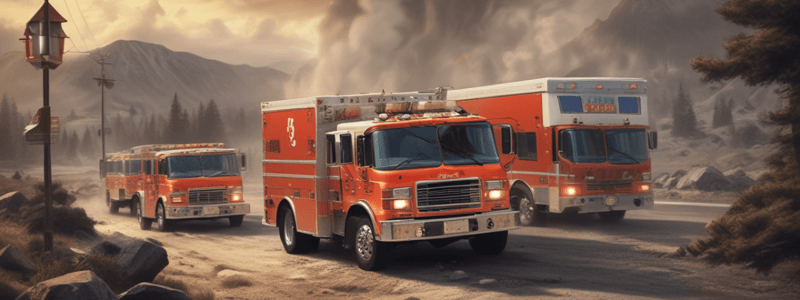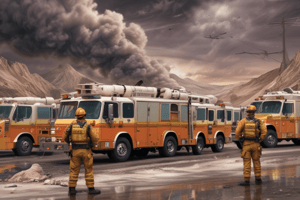Podcast
Questions and Answers
Who has jurisdictional policing authority on all provincial highways?
Who has jurisdictional policing authority on all provincial highways?
- Toronto Fire Services
- Paramedic Services
- Joint Commanders
- Ontario Provincial Police (OPP) (correct)
Who is responsible for the redirection of traffic at emergency incidents?
Who is responsible for the redirection of traffic at emergency incidents?
- Paramedic Services
- Police personnel (correct)
- Joint Commanders
- Firefighting personnel
When can TFS not wait for the Police to arrive?
When can TFS not wait for the Police to arrive?
- If the patient is transported or the scene has been stabilized (correct)
- If there is an imminent risk to Public Safety
- If the apparatus is not positioned safely
- If there are fluids or wires down on the road
What should apparatus be positioned to do until Police arrive?
What should apparatus be positioned to do until Police arrive?
How many traffic lanes should apparatus occupy during emergency operations?
How many traffic lanes should apparatus occupy during emergency operations?
Who may remove or direct others to remove vehicles from a provincial highway?
Who may remove or direct others to remove vehicles from a provincial highway?
What should be used to define a hot zone or work area?
What should be used to define a hot zone or work area?
When should apparatus be positioned in the flow of traffic?
When should apparatus be positioned in the flow of traffic?
When should Incident Commanders request Police for traffic control?
When should Incident Commanders request Police for traffic control?
What is the role of the Incident Commander?
What is the role of the Incident Commander?
What is the priority after emergency operations are complete?
What is the priority after emergency operations are complete?
Who should establish communications between allied agencies?
Who should establish communications between allied agencies?
What should be used to direct traffic flow safely around the parked apparatus?
What should be used to direct traffic flow safely around the parked apparatus?
Why is it not recommended to use safety cones behind a blocker truck?
Why is it not recommended to use safety cones behind a blocker truck?
Who can call for additional blocker apparatus?
Who can call for additional blocker apparatus?
What should all TFS employees not involved in active firefighting activities do?
What should all TFS employees not involved in active firefighting activities do?
Flashcards are hidden until you start studying
Study Notes
Unified Command
- The first arriving apparatus establishes the Command, and the Incident Commander conducts a size-up and stabilizes the scene.
- The Incident Commander's role may transition between emergency response agencies as the incident progresses.
- The Incident Commander's responsibility may shift from one agency to another, depending on the incident's requirements (e.g., medical treatment, extrication, or investigation).
Police Jurisdiction
- The Ontario Provincial Police (OPP) have jurisdictional authority on provincial highways.
- The OPP have the authority to remove or direct others to remove vehicles from provincial highways, with or without being present on the scene.
- Police personnel are responsible for redirecting traffic at emergency incidents.
- Until Police arrive, apparatus should be positioned to redirect traffic and protect personnel on the scene.
Traffic Control
- Traffic control is the responsibility of law enforcement personnel.
- Incident Commanders should request Police assistance for traffic control when personnel are subjected to hazardous traffic flow.
- In certain situations, TFS are not required to wait for Police to arrive (e.g., patient transported, scene stabilized, no imminent risk to public safety).
- Do not use traffic cones behind apparatus.
Apparatus Positioning
- Apparatus should be safely positioned in the vicinity of the incident location, taking into account the situation.
- Proper apparatus positioning is crucial for personnel safety.
- Apparatus should:
- Take one traffic lane more than required for emergency operations.
- Be positioned off the roadway and on the shoulder area as soon as possible.
- Be angled across a roadway to close the road off from vehicular traffic in certain situations.
- On roadways with speeds less than 90 km/h, apparatus may be positioned to close the road off from vehicular traffic, with cones directing traffic flow safely around the parked apparatus.
Studying That Suits You
Use AI to generate personalized quizzes and flashcards to suit your learning preferences.



